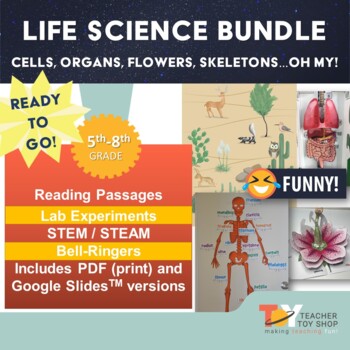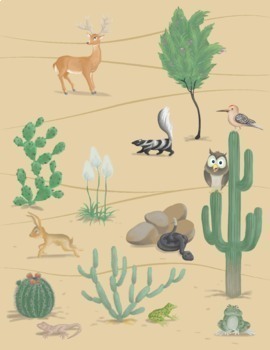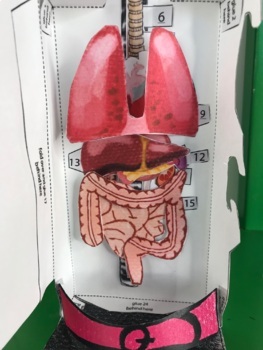Life Science Activities and Lessons Bundle - Labs, Interactive Notebooks, more
Teacher Toy Shop
388 Followers
Grade Levels
5th - 8th, Homeschool
Subjects
Resource Type
Standards
NGSSMS-LS1-5
NGSSMS-LS1-7
NGSSMS-LS1-2
NGSSMS-LS2-2
NGSSMS-LS2-3
Formats Included
- Zip
- Easel Activity
- Easel Assessment
Teacher Toy Shop
388 Followers

Includes Google Apps™
This bundle contains one or more resources with Google apps (e.g. docs, slides, etc.).
Easel Activities Included
Some resources in this bundle include ready-to-use interactive activities that students can complete on any device. Easel by TPT is free to use! Learn more.
Easel Assessment Included
Some resources in this bundle include self-grading quizzes that students can complete on any device. Easel by TPT is free to use! Learn more.
Products in this Bundle (21)
showing 1-5 of 21 products
Description
All of Teacher Toy Shop's Life Science resources in one place! Some biology topics included: cells, ecosystems, human body systems and organs, flowers, reproduction, human eye, and more. Includes NGSS aligned lessons, experiments using the Scientific Method, and more.
Purchase this bundle for a low-price now, and any future life science items from Teacher Toy Shop will be added to this bundle and FREE to you!
You may also be interested in:
- Pop-up Volcano
- Snap Circuits Lessons and Experiments
- Earth Science Bundle
- Sound and Light Waves Science Experiments
* Visit my store and click on the green star to be the first to know about new products, sales and freebies.
** Please remember to rate this product so that you earn TPT Credits for future purchases!
Total Pages
Answer Key
Included
Teaching Duration
N/A
Report this resource to TPT
Reported resources will be reviewed by our team. Report this resource to let us know if this resource violates TPT’s content guidelines.
Standards
to see state-specific standards (only available in the US).
NGSSMS-LS1-5
Construct a scientific explanation based on evidence for how environmental and genetic factors influence the growth of organisms. Examples of local environmental conditions could include availability of food, light, space, and water. Examples of genetic factors could include large breed cattle and species of grass affecting growth of organisms. Examples of evidence could include drought decreasing plant growth, fertilizer increasing plant growth, different varieties of plant seeds growing at different rates in different conditions, and fish growing larger in large ponds than they do in small ponds. Assessment does not include genetic mechanisms, gene regulation, or biochemical processes.
NGSSMS-LS1-7
Develop a model to describe how food is rearranged through chemical reactions forming new molecules that support growth and/or release energy as this matter moves through an organism. Emphasis is on describing that molecules are broken apart and put back together and that in this process, energy is released. Assessment does not include details of the chemical reactions for photosynthesis or respiration.
NGSSMS-LS1-2
Develop and use a model to describe the function of a cell as a whole and ways the parts of cells contribute to the function. Emphasis is on the cell functioning as a whole system and the primary role of identified parts of the cell, specifically the nucleus, chloroplasts, mitochondria, cell membrane, and cell wall. Assessment of organelle structure/function relationships is limited to the cell wall and cell membrane. Assessment of the function of the other organelles is limited to their relationship to the whole cell. Assessment does not include the biochemical function of cells or cell parts.
NGSSMS-LS2-2
Construct an explanation that predicts patterns of interactions among organisms across multiple ecosystems. Emphasis is on predicting consistent patterns of interactions in different ecosystems in terms of the relationships among and between organisms and abiotic components of ecosystems. Examples of types of interactions could include competitive, predatory, and mutually beneficial.
NGSSMS-LS2-3
Develop a model to describe the cycling of matter and flow of energy among living and nonliving parts of an ecosystem. Emphasis is on describing the conservation of matter and flow of energy into and out of various ecosystems, and on defining the boundaries of the system. Assessment does not include the use of chemical reactions to describe the processes.





